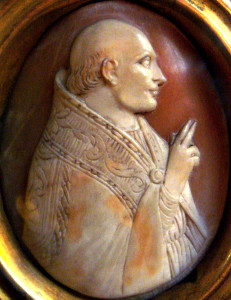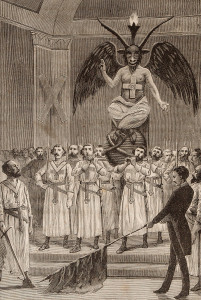In this installment of Symbols & Symbolism, we look at a reading from Albert G. Mackey’s Encyclopedia of Freemasonry, on the infamously nefarious figure of Baphomet – the alleged false idol of the knights Templar and one of the key instruments of their undoing by Pope Clement.
More installments of Symbols & Symbolism are available here and on YouTube.

Pope Clement V
The imaginary idol, or, rather, symbol which the Knights Templars were accused of employing in their mystic rights. The forty-second of the charges preferred against them by Pope Clement is in these words:
Item quod ipsi per singulas provincias habeant idola: videlicet capita quorum aliqua habebant tres facies, et alia unum: et aliqua cranium humanum habebant.
Also, that in all of the provinces they have idols,namely, heads, of which some had three faces, some one, and some had a human skull.
Von Hammer, a bitter enemy of the Templars, in his book entitled The Mystery of Baphomet Revealed, revived this old accusation, and attached to the Baphomet an impious signification. He derived the name from the Greek words, Baph (βάπτισμα) – baptism, and μhtis (σοφία) – wisdom, and thence supposed that it represented the admission of the initiated into the secret mysteries of the Order. From this gratuitous assumption he deduces his theory, set forth even m the very title of his work, that the Templars were convicted, by their own monuments, of being guilty as Gnostics and Ophites of apostasy, idolatry, and impurity. Of this statement he offers no other historical testimony than the Articles of Accusation, themselves devoid of proof, but through which the Templars were made the victims of the jealousy of the Pope and the avarice of the King of France.

Baphomet as imagines in the Taxil Hoax
Others again have thought that they could find in Baphomet a corruption of Mahomet (Mohammed), and hence they have asserted that the Templars had been perverted from their religious faith by the Saracens, with whom they had so much intercourse, sometimes as foes and sometimes as friends. Nicolai, who wrote an Essay on the Accusations brought against the Templars, published at Berlin, in 1782, supposes, but doubtingly, that the figure of the Baphomet, figura Baffometi, which was depicted on a bust representing the Creator, was nothing else but the Pythagorean pentagon, the symbol of health and prosperity, borrowed by the Templars from the Gnostics, who in turn had obtained it from the School of Pythagoras.
King, in his learned work on the Gnostics, thinks that the Baphomet may have been a symbol of the Manicheans, with whose wide spreading heresy in the Middle Ages he does not doubt that a large portion of the inquiring spirits of the Temple had been intoxicated.
Amid these conflicting views, all merely speculative, it will not be uncharitable or unreasonable to suggest that the Baphomet, or skull of the ancient Templars, was, like the relic of their modern Masonic representatives, simply an impressive symbol teaching the lesson of mortality, and that the latter has really been derived from the former.




Continue reading...
More installments of Symbols & Symbolism are available here and on YouTube.

Pope Clement V
The imaginary idol, or, rather, symbol which the Knights Templars were accused of employing in their mystic rights. The forty-second of the charges preferred against them by Pope Clement is in these words:
Item quod ipsi per singulas provincias habeant idola: videlicet capita quorum aliqua habebant tres facies, et alia unum: et aliqua cranium humanum habebant.
Also, that in all of the provinces they have idols,namely, heads, of which some had three faces, some one, and some had a human skull.
Von Hammer, a bitter enemy of the Templars, in his book entitled The Mystery of Baphomet Revealed, revived this old accusation, and attached to the Baphomet an impious signification. He derived the name from the Greek words, Baph (βάπτισμα) – baptism, and μhtis (σοφία) – wisdom, and thence supposed that it represented the admission of the initiated into the secret mysteries of the Order. From this gratuitous assumption he deduces his theory, set forth even m the very title of his work, that the Templars were convicted, by their own monuments, of being guilty as Gnostics and Ophites of apostasy, idolatry, and impurity. Of this statement he offers no other historical testimony than the Articles of Accusation, themselves devoid of proof, but through which the Templars were made the victims of the jealousy of the Pope and the avarice of the King of France.

Baphomet as imagines in the Taxil Hoax
Others again have thought that they could find in Baphomet a corruption of Mahomet (Mohammed), and hence they have asserted that the Templars had been perverted from their religious faith by the Saracens, with whom they had so much intercourse, sometimes as foes and sometimes as friends. Nicolai, who wrote an Essay on the Accusations brought against the Templars, published at Berlin, in 1782, supposes, but doubtingly, that the figure of the Baphomet, figura Baffometi, which was depicted on a bust representing the Creator, was nothing else but the Pythagorean pentagon, the symbol of health and prosperity, borrowed by the Templars from the Gnostics, who in turn had obtained it from the School of Pythagoras.
King, in his learned work on the Gnostics, thinks that the Baphomet may have been a symbol of the Manicheans, with whose wide spreading heresy in the Middle Ages he does not doubt that a large portion of the inquiring spirits of the Temple had been intoxicated.
Amid these conflicting views, all merely speculative, it will not be uncharitable or unreasonable to suggest that the Baphomet, or skull of the ancient Templars, was, like the relic of their modern Masonic representatives, simply an impressive symbol teaching the lesson of mortality, and that the latter has really been derived from the former.
Continue reading...